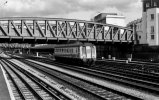One thing that's always struck me about the London suburban network is the almost rural nature of the local service between Paddington and Slough, particularly before Turbos were introduced and the 15-min interval service came into being (I can't remember if these occurred simultaneously). In the 60s, 70s and 80s, the service was half hourly, run by 117 DMUs.
Namely did they ever consider a small electrification project between Paddington and Slough, to provide a high-frequency suburban service (similar to the Gidea Park route on the other side of London perhaps) to Hayes, Southall etc? Perhaps it could have been done around 1976 and a batch of 313s used, for example, to provide a 15-min frequency all-stations service out to Slough. The DMUs for Reading and Oxford could then have fit in the gaps in between the electrics: the slower speed of the DMUs would be compensated by the fact that they would miss most stops. Such a service pattern was seen on the Altrincham line for example.
Maybe it was something to do with the nature of that corridor in west London and its population levels (lots of industry, but not especially high population) at the time? Certainly stood out as a London suburban service that didn't have the high-frequency electric service typical of most of London.
Namely did they ever consider a small electrification project between Paddington and Slough, to provide a high-frequency suburban service (similar to the Gidea Park route on the other side of London perhaps) to Hayes, Southall etc? Perhaps it could have been done around 1976 and a batch of 313s used, for example, to provide a 15-min frequency all-stations service out to Slough. The DMUs for Reading and Oxford could then have fit in the gaps in between the electrics: the slower speed of the DMUs would be compensated by the fact that they would miss most stops. Such a service pattern was seen on the Altrincham line for example.
Maybe it was something to do with the nature of that corridor in west London and its population levels (lots of industry, but not especially high population) at the time? Certainly stood out as a London suburban service that didn't have the high-frequency electric service typical of most of London.

